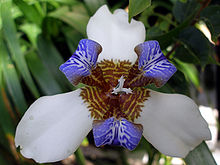- Neomarica
-
Neomarica 
Neomarica caerulea Scientific classification Kingdom: Plantae (unranked): Angiosperms (unranked): Monocots Order: Asparagales Family: Iridaceae Subfamily: Iridoideae Tribe: Mariceae Genus: Neomarica
SpragueType species Neomarica northiana
(Schneevogt) SpragueSpecies See text
Neomarica (Walking Iris or Apostle Plant) is a genus of 16 species of plants in family Iridaceae, native to tropical regions of western Africa, and Central and South America, with the highest diversity (12 species) in Brazil. The genus name is derived from the Greek words neo, meaning "new", and Marica, the Roman nymph.[1]
Contents
Description
They are herbaceous perennial plants that propagate by way of a thick rhizome and new plantlets that develop from the stem where flowers once emerged. The plants grow erect, and have long slender lanceolate leaves from 30-160 cm long and 1-4 cm broad, depending on the species. They produce very fragrant flowers that last for a short period of time, often only 18 hours.
The flowers emerge from what appears to be just another leaf, but is really a flower stalk structured to look like the other leaves; they are 5-10 cm diameter, and closely resemble Iris flowers. After pollination, the new plantlet appears where the flower emerged and the stalk continues to grow longer. The weight of the growing plantlet causes the stalk to bend toward the ground, allowing the new plantlet to root away from its parent. This is how it obtained the common name of "Walking Iris". The other common name "Apostle Plant" comes from the belief that the plant will not flower until the individual has at least 12 leaves, the number of apostles of Jesus.
Species
- Neomarica caerulea
- Neomarica capitellata
- Neomarica caulosa
- Neomarica fluminensis
- Neomarica gracilis
- Neomarica imbricata
- Neomarica longifolia
- Neomarica nitida
- Neomarica northiana
- Neomarica paradoxa
- Neomarica portosecurensis
- Neomarica rotundata
- Neomarica rupestris
- Neomarica sabini
- Neomarica silvestris
- Neomarica variegata
Cultivation and uses
Some Neomarica species such as N. northiana, N. longifolia, and N. caerulea are common ornamental plants that are easily cultivated both in gardens in subtropical and tropical regions, and as houseplants in temperate areas.
References
Categories:- Iridaceae genera
Wikimedia Foundation. 2010.

